In which I share my Ikea hack standing desk / Ikea hack treadmill desk made from an Ikea ALEX desk, GERTON legs, EKBY LÄRPEN shelf & CAPITA brackets, plus how I hacked two different treadmills to work with the desk.
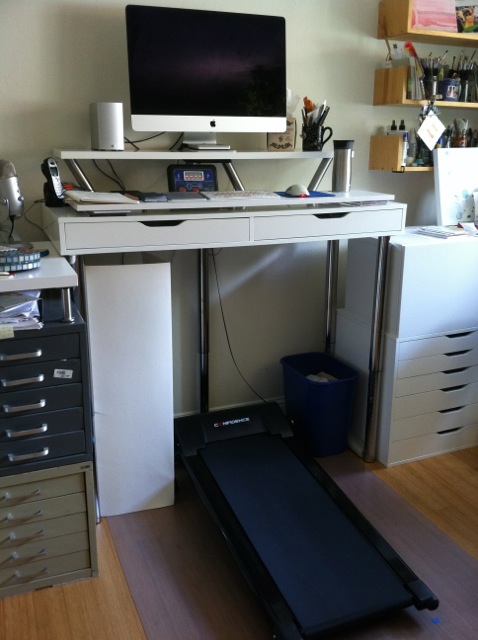
1,605.7 miles. That’s just over half the distance from here to New York City.
It’s also how many miles I’ve logged on my Nike+ account in the one year since I bought my Nike+ Sportband, and I logged almost all of those miles while working at my computer (in fact, I’m walking right now as I type this!)
Huh? A Treadmill Desk?
Yep, I don’t just have a standing desk; I have a treadmill desk, and I love my it! Making the switch from sitting to office walking has been an enormous quality of life boost. Since getting my (first) treadmill in May of 2013:
- My back doesn’t hurt all the time anymore. (I have scoliosis, so my back is always in a state of some discomfort, but I had no idea how much sitting was killing me until I stopped! Thanks to office walking — and my brilliant samurai massage therapist — my daily pain level has dropped dramatically.)
- I’ve shrunk the layer of middle-age fat that was rather annoyingly starting to accumulate around my middle.
- My leg muscles are rather impressively hard and toned.
- I have more energy.
- My mood is better.
- It’s easier to maintain better posture throughout the day, which, in turn, helps my back.
- Instead of being a computer chair potato, I’m now walking an average of 3-7 miles a day! Some days as many as 10-15 miles!
In fact, I’ve become something of a treadmill desk evangelist, always raving about the benefits of office walking. The world would be a healthier, happier place if all office workers had treadmill desks!
Sitting is the New Smoking
Sedentary office lifestyles are pretty common here in Silicon Valley, but that doesn’t mean they’re good for us. Human bodies are made to move, not to sit!
They say that sitting is the new smoking — that’s how bad it is for you.
I used to fantasize about living in an area where I could walk everywhere, as I did during the two years when I lived in New York City and in Birmingham, England. I was especially fit during those years, because I didn’t have a car, and so I had to walk a lot. And because of excellent public transportation, I could get just about anywhere I wanted pretty easily without driving.
Now I live in a suburban neighborhood, where most stores are just too far away to make walking realistic, and public transportation is pathetic. And I’m just too lazy and rain-shy to get into biking everywhere.
With my treadmill desk, though, those old fantasies have all but disappeared. I don’t need to live right downtown to walk every day! In fact, I’m quite sure I walk more with my treadmill than I ever did during my two car-free years. Even though I’m not getting a very intense cardio workout (I generally walk between 2-3 mph), I’m moving!
Challenges of Treadmill Desk Walking
Almost everyone who hears about my treadmill desk expresses astonishment that I can type while I’m walking, but trust me, that’s the easy part.
If you can push a shopping cart through a grocery store, you can type while you walk.
Really.
The trick is simply to set up a typing surface at the right height. It might take a day to get used to walking on a treadmill, which feels a bit odd at first, compared to walking on regular ground, but believe me, you’ll be typing easily within a few minutes.
The bigger problem, I found, is building up endurance and finding the right shoes.
Yes, walking places different demands on your body than sitting (or even standing). I suffered from blisters, arch pain, and sore knees while my body got used to walking for miles a day.
Part of this was because I was too impatient to start slowly. Take my advice: start slowly! I recommend 20-30 minutes a day max for the first few days, then build up a few minutes a day from there.
I started with an hour a day. Given that a once-a-week 45-minute walk was a Big Deal for me back then, this was not my wisest moment…
The blisters quickly showed me that none of the shoes I had were going to work in the long run, so spent a good two hours at a running store that specializes in custom-fittings, only to take those shoes back a month later because they were causing pain in the outer side of my foot.
Turns out the sole was squishier on the outer side, and my right foot rolls in such a way that it was getting repeatedly stressed. (This is why I’m a believer in patronizing local stores that know what they’re doing: I took the (now used) shoes back, and after another 90 minutes of fit tests, they happily traded them in for a different pair, which worked like a charm (in fact, they’re due for a replacement, I’m sure…))
(That’s when I also bought the Nike+ Sportband, to have an easy way to track my mileage, and with a Polar heart rate strap, it can monitor my heart rate, too, which is pretty nifty.)
Also, be advised that, even though I’m not getting an extreme cardio workout from walking 2-3 mph, I do work up a sweat. Walking in dressy office attire is probably not ideal, so if you’re setting up a treadmill desk at an office, bring a change of clothes to work!
Standing Desk Hack #1
I bought my first treadmill in late May of 2013, and after scouring the internet for cheap treadmill desk / standing desk hacks, I drove to Ikea and bought a LACK side table for $9.99, which I stacked on top of my computer desk to make a standing-desk-height surface.
To get my screen to a good height, I raised my iMac several inches with a few reams of paper, which rested on the end of a long cutting board (one of those pull-out kinds from the kitchen), the other end of which stuck out beyond the edge of the side table to serve as a makeshift keyboard shelf.
For almost a year, this is what my set-up looked like:

Not pretty, but functional. Or rather, functional enough… for the time being.
This rickety contraption was definitely not something that would be approved by OSHA, nor was it ergonomic (the keyboard was a few inches too high for me), but thankfully no disasters befell, and it allowed me to walk for close to a year before I finally implemented a more permanent (not to mention attractive, comfortable, and safe) solution.
More on that below…
The Treadmill Part of the Treadmill Desk
Choosing a Treadmill
I’ve actually used two different treadmills — the Confidence GTR Power Pro (aff link) and the Confidence Power Plus (aff link). I’ll explain why I’ve had two, and the differences between them, in the next sections.
Back in May of 2013 I bought my first treadmill off Amazon, a Confidence GTR Power Pro (I paid $249, but the model has changed, and the price has gone up to $263 on Amazon). I chose this particular model because I’d read about several people hacking Confidence treadmills into walking desks, and this model seemed a little easier to hack than its cheaper cousin, the Confidence Power Plus (aff link – currently $199 on Amazon). Because it also has a little more power than the Power Plus, I reasoned that it might last longer.
In addition, both Confidence models have a particular feature of stopping automatically after a certain length of time — the Power Plus after 30 minutes, and the GTR Power Pro after 60 minutes — and I thought I might get annoyed at being stopped without warning every half hour, whereas every hour might be a good time to stop, stretch, and rest my eyes.
In fact, after using both, I’ve decided I rather prefer the 30-minute auto-stop. Some hackers have figured out how to stop this feature, but I’ve grown to like it, as it serves as a built-in timer, and even though I don’t always take a stretch break, at least it reminds me to do so. 😉
I did look online for other alternatives to the Confidence treadmills, and there are many. A quick search of Craigslist will show you dozens of treadmills languishing in garages and spare bedrooms, but most of these are monstrous machines that take up a lot of space, with chunky, non-removable handlebar setups, which would require a much more extensive hack job than I wanted to undertake — essentially custom-building a desktop around the bulky front part of the treadmill.
Lots of people have done it to great effect, but I wanted something more streamlined.
One of the things I like about both Confidence models is how small they are: the Power Plus platform is only 20″ wide and less than 48″ long! The GTR Power Pro is slightly larger. If you’re a very tall person, and/or if you want to use the treadmill for running, this platform may feel a bit small, but for me (5′ 8″ tall) it’s been perfect.
If you’ve got money to burn, nowadays you can also find all kinds of (expensive!) treadmills that are made explicitly for office walkers, with springy platforms that are easy on your joints. Some companies are now even building all-in-one treadmill desks with adjustable-height desk areas, but these do not come cheap — $2,000 and up is not unusual. Plus beware that some of them limit your speed to 2 mph max (too slow for me!), and many do not offer the option of an incline.
Both Confidence treadmills can be set to a shallow incline (the Power Pro default state is actually slightly inclined, but you can always raise the end on blocks to make it flat if you wish), and I actually prefer a slight incline, as I find it easier on my knees, plus it gives me a better workout.
Hacking the Confidence GTR Power Pro Treadmill
To get the Confidence GTR Power Pro treadmill to work with the desk was relatively simple. This particular model comes partially assembled, with the horizontal handlebars unattached to the vertical arms.
Here’s a pic of what it looks like fully assembled:

We left the handlebars off, which allowed us to fold the vertical supports down alongside the platform, out of the way of my desk.
The console had to be removed with a screwdriver, which was easy enough. The only tricky part was the cable that connects the console to the treadmill — that cable runs through the hollow handlebars, and plugs into an outlet at the top of the right vertical support.
Just in case we might want to assemble the treadmill later, we tied a long string of dental floss to the end plug of the cable, and taped one end of it to the handlebar before pulling it out. That would act as a “needle threader” to enable us to reverse the process later.
The end of the cable looks a lot like a telephone cable, but smaller. Thankfully, MM recognized that it was the same kind of plug used on old fashioned landline telephone handsets, so we went to Fry’s and bought a long, curly telephone handset cable, which you can see in the picture of my first treadmill desk above, stretching from the lower right end of the treadmill up to the cable coming out from the console.
Once the treadmill was plugged in, and the console cable attached with the curly cable, I was up and running! Er, walking.
Treadmill Lessons
This treadmill served me well for many months. Unfortunately, though, I didn’t realize that I needed to lubricate the belt platform regularly. Oops…
Several months in, the belt started slipping. Thankfully, I was only walking, not running, or this could have caused a very serious accident.
To solve the slipping problem, first I tried tightening the belt, which helped for awhile. When that stopped working, I discovered I should have been lubricating lo these many months, and I tried lubricating it, which also helped for awhile, but eventually it just gave out.
Luckily, a random Craigslist search landed us a barely-used Confidence Power Plus treadmill for just $70. Sweet! These puppies (basically a slightly less powerful and smaller version of the Confidence GTR Power Pro) normally go for $199 on Amazon, so this was a great steal!
Hacking the Confidence Power Plus Treadmill
Unlike the GTR Power Pro, the Power Plus treadmill has essentially a U-shaped handlebar setup, so folding the handlebars down by the platform was not an option.
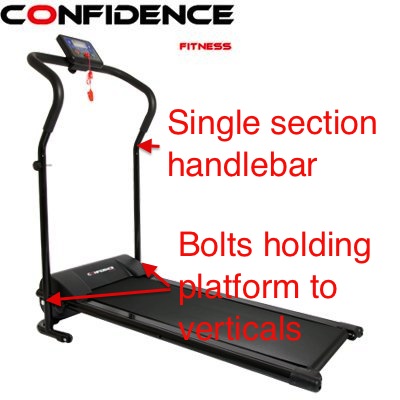
Following the advice of some previous treadmill hackers I found online, we initially removed the entire handlebar assembly, by taking out two bolts attaching it to the treadmill platform.
As with the GTR Power Pro, the console unit (much smaller on the Power Plus) had to be removed with a screwdriver, and the cable pulled out of the hollow handlebars. (We used the dental floss trick again, to ensure that we could thread the cable back through later if we wanted.)
Initially, this worked great. However, when you take the treadmill apart in this way, the motor section rests on its plastic housing, which it probably wasn’t designed to do. MM was concerned that the repeated pounding of my feet would ultimately crack and break the plastic housing, dropping the motor onto the floor, which would not be a good thing if it happened while I was walking!
So after a few weeks MM hacksawed the vertical supports a few inches above the bolts, and we reattached the platform. This had (for me) the advantage of giving the treadmill platform a slight incline, which, as I’ve mentioned, I find easier on my knees, as well as a better workout bang for my buck.
Unlike the GTR Power Pro, the cable from the console of the Power Plus is long enough to reach from my desktop (where the console sits) down to the treadmill. Plus the smaller console fits more easily on my desk.
As of this writing, I can’t speak to the longevity of the Power Plus, since I’ve only been using it for a few months. I have, however, been lubricating every week or so, and hope this helps this machine to last longer than its predecessor!
The Desk Part of the Treadmill Desk
My initial $9.99 Ikea hack was tolerable, but for close to a year I was chomping at the bit to come up with a better solution. At first, I thought that would come in the form of a height-adjustable desk — one that would go from standing height to sitting height with the push of a button.
There are plenty of options out there for this kind of thing, but they’re expensive ($800-$1,000 is cheap for a height-adjustable table!), so I held off.
Then there was the question of what size desk to get. My computer desk was six feet long, and my original thought was to simply replace it with a six-foot long height-adjustable table.
But then I saw this post, which had me dreaming of overhauling my studio, replacing the hand-me-down furniture, and finally creating a studio that I really loved!
This dream was limited by the reality that my studio was swimming in clutter. Almost two decades’ worth of stuff that I really didn’t need, but hadn’t been able to let go of. I’d never managed to clutterbust this part of the house because the task was just so herculean!
So I started the Great ClutterBust in order to help me do the impossible. Once the clutter was cleared out, I had the mental space to start thinking about what my dream studio would actually look like.
Meanwhile, after close to a year of using my temporary treadmill desk, I realized that I didn’t really need a height-adjustable table. I’d given my office chair to my husband, and never actually sat in a chair while working anymore! If I feel like getting off my feet, I’ll set a stool on my treadmill and perch on that, but I never have a call to lower my desk to chair-height.
All of which meant that I wasn’t limited by what affordable height-adjustable tables I could find! The world was suddenly open to me!
I spent a few weeks scouring the internet for ideas, drawing out furniture layouts on grid paper, and calculating costs. Ultimately, I completed my studio overhaul with Ikea furniture (and lots of help from MM), and the final piece was finishing up my Ikea hack standing desk / treadmill desk.
I knew I wanted easily-accessible drawers, and legs that could adjust if the height of my treadmill ever changed. I also needed a way to raise my computer monitor to the right height. And above all, I wanted it to be pretty.
I was sick and tired of living like a student (and a slobby student at that!) I wanted my desk area to feel spacious, with clean lines, and lots of white space. And cable management! No more tangled nests of wires dangling every which where!!
Ultimately, I patched together a bunch of Ikea products to create a workstation and storage units that hold everything I need efficiently, and look good while doing it.
This post tells the story of the first part of creating my Ikea hack standing desk / treadmill desk. Here’s what it looked like after part one:
In short, we took the top part of an Ikea ALEX desk ($159), and screwed four GERTON legs ($30 each) to the bottom. (Read this post for more details.)
As you can see from the snapshot, my computer was still resting on paper reams, plus the weight of the computer caused a bit of bowing to the desktop, so phase two was to add a monitor shelf — inspired by this pic, and this, and this — and a fifth leg to help eliminate the bowing. We also wanted to somehow attach the desk to a wall stud, to keep it from toppling in an earthquake (this being California…)
I knew this would be a Big Project, so it took us a solid month to get around to it. Then finally we set aside a full weekend to work on this project, and we Got It Done!
First, after taking everything off and out of the desk (naturally), we carefully flipped it upside down and screwed in the fifth leg in the center back. That was the easy part.
Then we had to figure out how to get those angled CAPITA brackets attached to the EKBY JÄRPEN shelf, and to the desktop.
(Note: It would have been much more efficient to attach the shelf to the desktop prior to assembling the desk, but the bolts on the CAPITA brackets were so long that they would interfere with the drawer movement if we didn’t have them cut. It took awhile to find a local person who could trim the bolts (without stripping the threading), which postponed the shelf assembly, and in the meantime, I’d sold my computer desk, and needed a desk! So we did things a bit backwards, assembling the desk first, and adding the shelf later.)
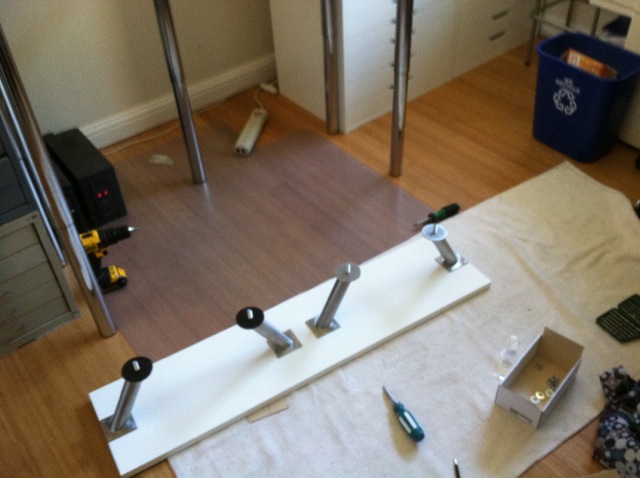
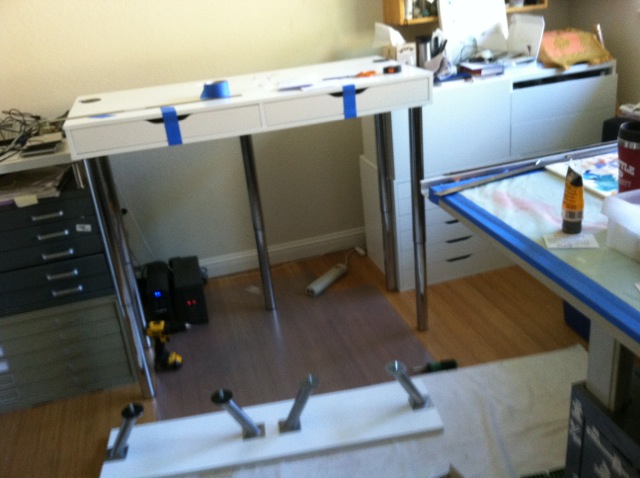
Measuring was tricky — we discovered when using a T-square that the EKBY JÄRPEN shelf is not truly square. The really tricky part, though, was figuring out how to mark the drill holes on the top of the desk without scratching it!
We decided to attach the brackets to the bottom of the shelf first, then carefully hold the shelf over the desk, using the black plastic “washers” from the CAPITA brackets to A) prevent scratching, and B) mark the spots where the holes should be drilled. Since the back of the ALEX desk flips up to reveal the built-in cable management, we had to make sure the CAPITA brackets didn’t extend beyond flush with the back edge of the non-movable part of the desktop, and the black plastic washers worked perfectly for this.
In the two pics below, you can see the black plastic washers, taped down with blue painters’ tape, being used as guides for the bolt holes:
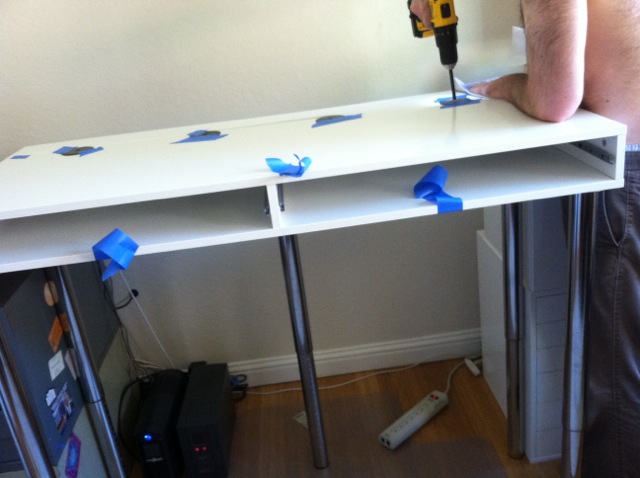
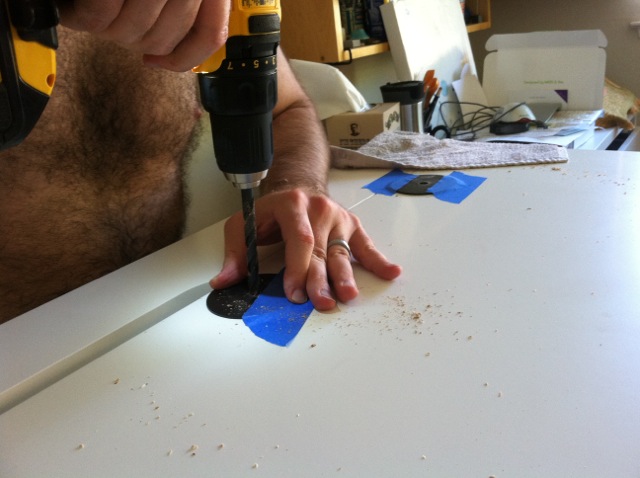
Several hours later, ta-da!
Here’s a close-up. In this pic we were using an orange C-clamp to “earthquake-proof” the iMac, but I’ve since discovered that this keeps the screen too close for my aging eyes, and switched to a velcro strap system to lash the “heel” of the iMac to the CAPITA brackets just below it.
You can also see that I’m using a separate shelf, stacked on a couple of CD jewel cases at either end, to raise my keyboard up a couple of inches.
I could also lengthen the adjustable GERTON legs, but I like the monitor at its current height, and am finding this setup to work quite nicely.
And here’s a blurry distance shot, which also shows, at the left of the image, the white LINMON tabletop + 4 short CAPITA legs, which function as a sort of enormous shelf on top of my flat files, providing hidden storage for my many internet-computery devices, a semi-hidden shelf for incoming mail, and a lovely white surface!
Another close-up, showing my treadmill console at the left:
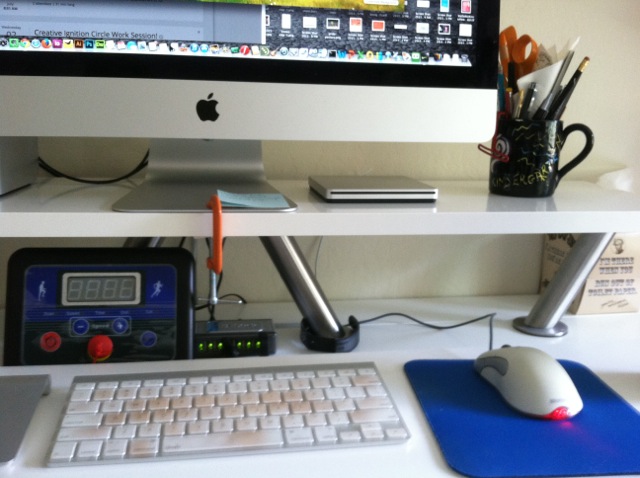
The earthquake safety system: black velcro strap encircling the GERTON leg and a (hidden) eye bolt, screwed into the stud (serendipitously located directly behind the leg!) The steel cable is my computer anti-theft cable.
And again, the final outcome:

And the lovely corner!

There’s still a bunch I want to do to beautify (and finish clutterbusting) — for example, painting the blonde wood tool shelves white to match the rest of my furniture — but walking into my studio now puts a smile on my face, and that is nothing short of a miracle.
Oh, and we did ALL of this for less than we would have spent on a height-adjustable table.
Walk on!
Writing this herculean post (over 3600 words) gave me an appreciation for how hard it is to explain engineering things in writing. If you have any questions, let me know in the comments and I’ll do my best to answer them!

PS — Pssst! Know someone who might benefit from seeing this today? Pass it on!

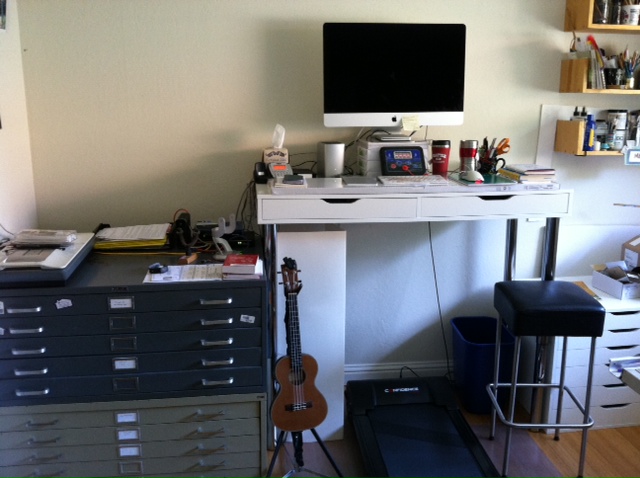
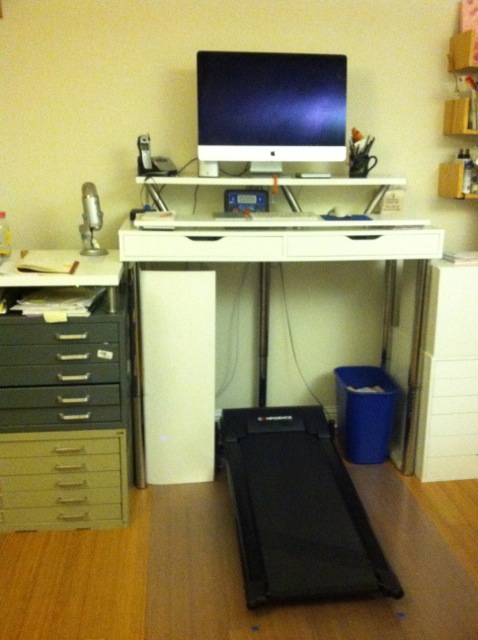

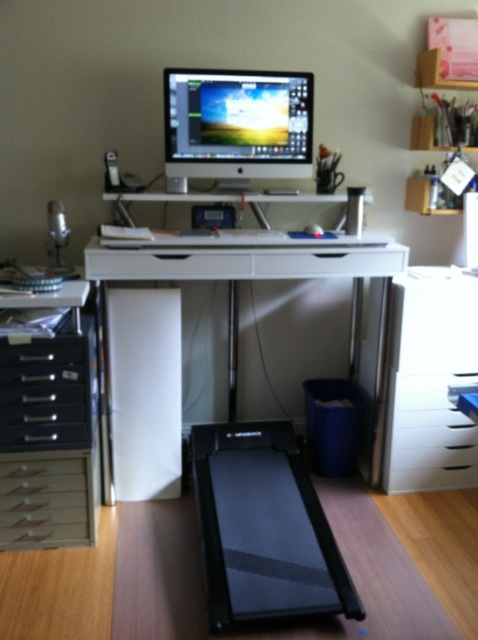
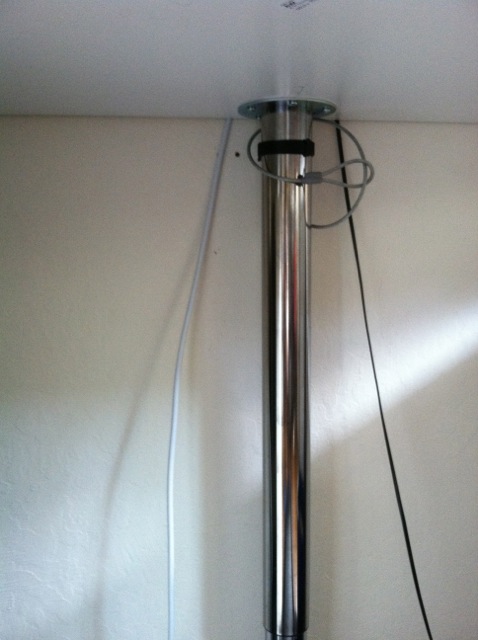




This post came at a perfect time. The bf and I have finally agreed to allow a little more clutter in our lives (our apartment is tiny for all of the furniture we have stuffed into it) and I’m working on my own desk treadmill now. I spent hours last night looking at all of the expensive options out there… I’m still weighing the frustrations of trying to build it myself over the frustrations of spending so much money. Either way though, it’s happening and this post is (and your last one) is super helpful. I didn’t even know about the lubrication maintenance so thanks for saving me the horror of having my treadmill break down! I’m so excited to start walking while I work…. no more struggling with the guilt of never finding time for fitness yay!!!
I’m so excited to hear you’re working on setting up your own treadmill desk, Bekah! Keep me posted — I’d love to know what you end up with! 🙂
Thank you for this post Melissa. I have passively thought that I would like to do this for a long time. About 9 years ago I put my computer up on one of my little fold up drawing tables so that I could stand at it, but just standing (even trying to dance a bit) for hours on end has been a challenge after awhile. After awhile I lowered my desk a bit and got a high stool, which has really not been the best choice. I do believe that walking (and of course that bit of dancing) would serve me much more. I intend to move in that direction (pun intended).
I find walking so much easier on my body, Dena. I know a lot of people have jumped on the standing desk bandwagon, but standing I find to be so hard on me! Walking obviously takes more energy, but it sure keeps my body happier. 🙂
That’s what I like to see: a shirtless man with drill in hand, making his lady’s life easier. #highfive
Yeah, baby! #highfiveback
Oh, awesome! If I could line up four small treadmills next to the big one and walk my dogs while I work, that’d be extra awesome! :o)
THAT would be so nifty! I would definitely want video! 🙂
Hi. You mention that you have had two treadmills. Which is the one you settled on as best?
I started with the Confidence GTR Power Pro, and now use the Confidence Power Plus. Which one is best would depend on what you are looking for. Here are some pros and cons of each:
GTR Power Pro (about $299 on Amazon):
Pros:
– A bit more powerful (2hp vs 1.5, I think (?)), which I thought would make it last longer. I haven’t used the other one long enough to have a basis for comparison, but only 9 months doesn’t seem very long. In fairness, it was probably cat hair sucked into the motor fan that caused the failure, but still…
– Auto-stops every 60 minutes, as opposed to every 30 minutes (which isn’t necessarily a con, actually…)
– The readout monitor does more stuff.
– Has built-in ability to be set at an incline (two different angles) or flat.
– No need to use a hacksaw to get rid of the vertical handlebar poles.
Cons:
– Larger footprint.
– More expensive.
– Heavier to move around.
– Need to buy a phone handset cable in order to use the readout monitor when not attached to the handlebars.
– Readout monitor is a lot bigger, so not as easy to set on a desktop without completely disassembling it.
Power Plus (about $199 on Amazon):
Pros:
– Smaller footprint.
– Lighter to move around.
– Less expensive.
– Readout monitor is much smaller and takes up less space.
– No need to buy a separate extension cable to use the readout monitor when not attached to handlebars.
Cons:
– Auto-stops every 30 minutes (although I’ve grown to sort of like this feature, so don’t consider it a con anymore).
– Readout monitor does less stuff.
– Not as easy to change the incline. (It has a bit of a built-in incline, though you could rest the back end of the treadmill on some boards or something, if you wanted to flatten it out. I like the incline, so this isn’t really a con for me.)
If I were starting from scratch, knowing what I know now, I’d save the extra $$ and start with the Power Plus. I’ve been very pleased with it. Though again, I haven’t had it long enough to be able to say if it will last as long or longer than the GTR.
Also, I now know that I need to LUBRICATE every 40 miles, which I was NOT doing with the GTR!
NOTE: I purchased a rechargeable, cordless stick vacuum so that I can vacuum on and around the treadmill DAILY. Since I have a (very fluffy) cat, and her litterbox is about eight feet away from the treadmill, this is critical! Treadmills and cat litter/cat hair do not play nice… 🙂
Could you share how noisy/quiet the Power Plus is? I am hoping to build a desk, based on your awesome instrctions, but this will be used in my office in a small business. Just worried about how loud this will be.
Thanks,
Jen
Hmmm… Not having a decibel meter, I’m not sure how to classify it. It seems pretty quiet, as motors go, but it’s definitely not silent. If I’m downstairs and my husband is using his Power Plus, I can hear his steps, and a light motor hum, coming from upstairs. Whether it would be loud enough to cause a problem in your office would depend on the sensitivity of your neighbors.
The loudest part, actually, is the beeping of the readout panel. Each time you turn it on, it beeps four times, pretty loudly, and also emits the same beep when you push any of the buttons.
Some users have disabled the beeping — search around on Google and you’ll find some posts that share how they did it.
Hope this helps!
Wow, Melissa! Applause, applause to your journey of clutter busting your studio and working through the treadmill desk scene, which got my heart racing, I admit. Such an engineering, drill, researching, buying experience…one that, I believe doesn’t jive with my hard-working partner’s temperament. Hmm….I will have to intend and muse on this, because I LOVE the idea of walking and working on my computer!!!! Many blessings, Happy New Year, and Happy Anniversary to you and MM!! Have a fabulous getaway! Blessings, Joy Resor (in Brevard, southwest of Asheville, who hopes to meet you this summer)
Thanks, Joy. 🙂 It was definitely a lot of work, but oh, so worth it! The cool thing is that sit/stand desks and treadmill desks are becoming more and more popular. Ikea recently came out with an electric, height-adjustable sit/stand desk for less than $500! And more and more companies are catering to the market of people who want to walk while working.
FYI, hacking the Confidence treadmill was pretty easy.
Looking forward to meeting in person!! 😀
You’re so welcome, Melissa! Isn’t that the best…when quite an effort is involved, and the result is totally awesome? I’m HAPPY for you!!!! Thank you….for your post has gotten me moving MORE, so we shall see where I go with the sit/stand desk situation. How fun it will be to meet you! Your energy is fantastic, and I’m all about living a creative, beautiful life! Blessings and love,
Joy
Yes, it is the best! 🙂 And YOU’RE the best. 🙂 xoxo
Thank you, Melissa!!!
Blessings upon blessings, Job
Melissa, how often do you sit on your stool on a given day? I’m trying to decide how wide of a desktop to buy – is it helpful to have room for a chair next to the treadmill?
Thanks and great job!
a
The only time I sit on my stool (usually) is when I’m on a call or hosting an online meeting. I used it more when I was first getting used to the standing desk, but now I stand (or walk) almost all the time. And since I don’t (yet) have the ability to adjust the height of my desk on the fly (that will be the next upgrade!), it’s really not comfortable for me to sit and type — my keyboard ends up being much too high for me. (More below…)
Oh – and how much height do I need to add to the desk to accommodate the height of the treadmill? How tall is your desk – just curious. thanks!
That is really going to depend on your particular treadmill, what kind of shoes you wear, your height, etc. There are some great schematics online showing how tall a standing desk should be (your elbows should be about 90 degrees when at the keyboard), but you’ll want to get someone to help measure (it’s really hard to do alone!)
For me, with this treadmill and wearing my running shoes, I set my keyboard height at 46″. The desktop is actually 44 1/2″ high, but they keyboard is raised another 1 1/2″ with a small bookshelp stacked on two layers of CDs (yeah, we’re really high-tech here 😉 ).
I think I originally did this thinking that I could just remove the shelf if I wanted to perch on the stool, and that would drop the keyboard closer to a better ergonomic height for stool-sitting. In reality, though, it’s more hassle than I can deal with to remove the shelf, so I never do!
Again, when I’ve got funds available for an upgrade, the next step will be to replace the Ikea legs with an electric base that will allow me to raise and lower the entire thing with the touch of a button. 🙂
Hope this helps!
Melissa, thanks for responding! Can you give us a brief update whether your treadmill is still working? Is the Power Plus still going strong? Oh, and did you ever have any issues with odors/off-gassing? I plan on using mine in a room that has poor ventilation.
THANKS!
P.S. I was just at IKEA trying to choose between the gerton legs w/ top or the bekant sit/stand electric desk. Sadly I don’t have the $$ for the latter. I do own a height adjustable stool though which i hope will make having non-adjustable desk less of an issue.
I’m on my third treadmill. The first one, the GTR Power Pro, lasted I think 9 months (???). I suspect it might have lasted longer had I known back then that these things should be LUBRICATED every 30 miles or so!!! *rolleyes*
I thought the GTR Power Pro would last LONGER than the Power Plus, because it has a bigger motor. In fact, though, I’ve been very happy with my Power Plus(ses), and appreciate their smaller footprint. The readout is less sophisticated, BUT it’s smaller, so it fits on my desk better.
And whereas the GTR Power Pro automatically stops after 60 mins, but Power Plus stops after 30. I thought this would bother me, but I find I don’t mind it at all — it helps me keep track of how long I’ve been going for, and is a good reminder to stretch, be mindful, drink water, etc.
(Not that I actually do these things… But it’s a good reminder to do them! 😉 )
I didn’t experience an issue with odor/off-gassing, but I may also not be as sensitive as you, so don’t take my experience as gospel.
Ikea’s price for the adjustable sit/stand desk is pretty amazing. You can also just buy the base for about $399 I think, then add your own table top. My desk area, is too narrow for a BEKANT, and my husband’s desk area is even narrower, but we’re planning on hacking a BEKANT base for him to make a 36″ wide sit/stand desk.
Then when it’s my turn to upgrade, I’m looking at some other bases on the market that are good widths for my space.
A lot of creative thinking goes into this stuff! 🙂
PS – For a really cheap starter standing desk (if you want to save up for a BEKANT or similar), I recommend my original solution: a LACK side table on top of a regular sitting-height desk. You can even attach a shelf to the legs for your keyboard platform. See http://www.huffingtonpost.com/2015/04/09/ikea-standing-desk-hack_n_7033432.html and http://www.homedit.com/ikea-standing-desk/ for more ideas.
Or just do a Google search — they’re EVERYWHERE! 🙂
WOW! Melissa!!…so is your third treadmill another Power Plus? Why do you think the 2nd one died? How long did it last?
I bought a Linnmon top and four gerton legs from IKEA this weekend…and it’s all set up. Everything feels solid and the set up was super easy. The bekannt sit/stand is really nice, but I couldn’t justify the cost since I am going to be the only one using the desk and I already own a tall stool.
I’m happy with it so far. Now I just need to buy a treadmill. I was leaning toward the gtr because of the 60 minute stop (I get interrupted a ton and it think having to turn on the power every 30 minutes would get on my nerves). So I am either going to get a PP or GTR or just splurging and getting the $700-$800 lifespan and let it take up all of my living room. 🙂
I got one GTR Power Pro. We’ve gotten three Power Pluses — one died, one I’m using right now, and one my husband (theoretically) uses. I don’t know why the second one died, but I expect that treadmills designed for short spurts at a high speed have a shorter shelf life when used for long walks at a low speed every day.
None of the regular treadmills are designed for walking long “distances.” The new breed of specialized office treadmills are more likely to last longer (I suspect), but they’re also a lot more expensive. I have a budget line item for treadmill replacement every 9-12 months.
thanks for the info and inspiration!
You’re welcome! 🙂
Hi Melissa,
I’ve been thinking about getting at least a sit/stand (adjustable) desk for a while. But the idea of adding a treadmill to the mix is really appealing. Just wondering what the latest is on how your Confidence treadmill has fared since you started lubricating it? i.e. how long does it last when used for regular low-pace walking?
I look forward to embarking on a similar journey 🙂
Graham
Hi Graham,
It’s a great question, and I’m afraid I don’t have a clear-cut answer, as I’ve lost track of how many treadmills we’ve been through! I think I’m on #3…? Or it could be #4…. It got confusing, because for awhile my husband had a treadmill, too, but then when mine burned out, he gave me his. Then we got him a replacement, and then his old one (which had been my new one) burned out, and he gave me his again.
I got my first treadmill in May of 2013, so not quite three years ago. Seems like they’ve been lasting somewhere around 3/4 of a year to a full year. I wish I could be more precise (tracking has never been my strong suit… 😉 )
In any case, I wish you a happy office-walking journey! 🙂
Melissa
I love this idea, but do you find that walking while you work affects your productivity? I would think that all the walking would be pretty distracting, even if it was at a really slow pace. I could see myself getting frustrated and just turning it off because I wanted to focus on something.
Actually, when I’m in a straight writing mode, I find it very helpful to walk. I think it helps me think better!
When I’m bouncing around from task to task, I often just stand instead of walking. But the nice thing about having a treadmill is that I can choose! I can start out walking, and then if it starts to annoy me I can stop. 🙂